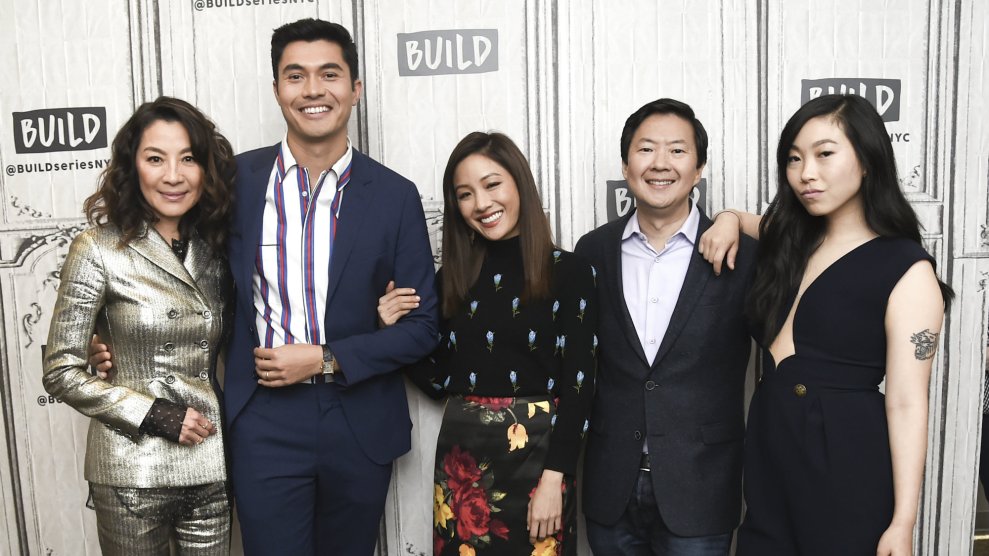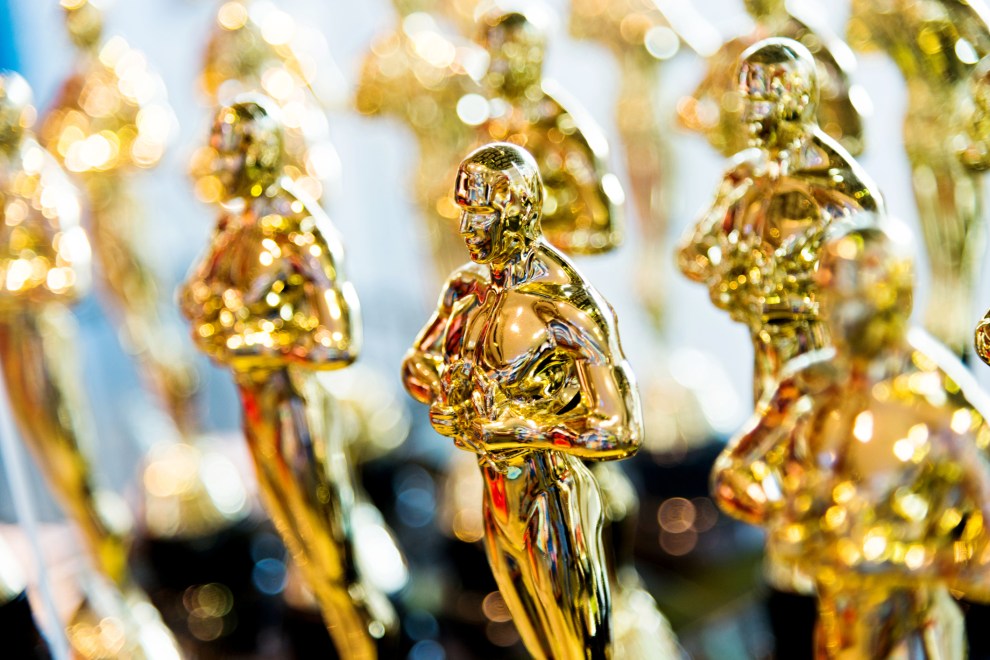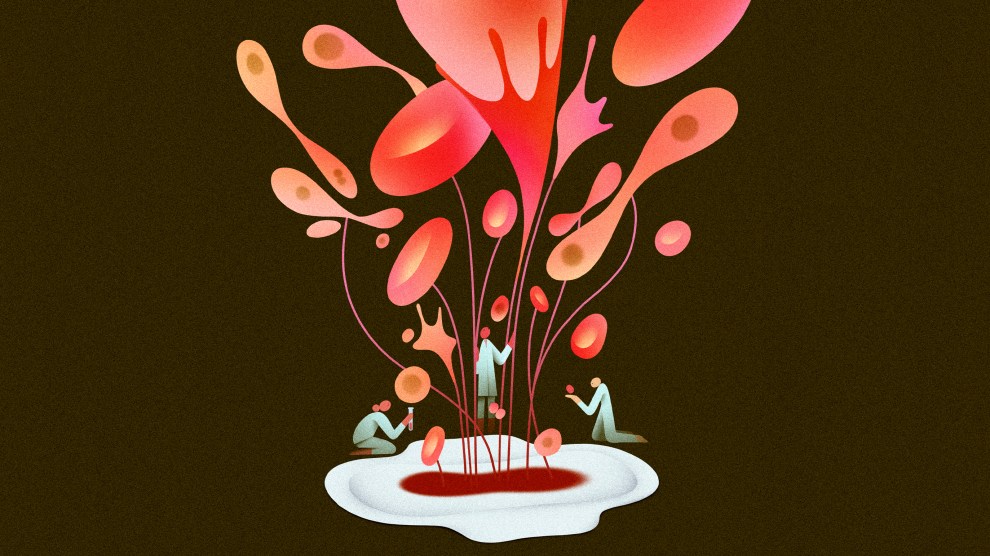
Members of the Crazy Rich Asians cast at an event in New York.Evan Agostini
Crazy Rich Asians debuted to crazy high expectations this week. Directed by Jon M. Chu, the film is one of the first major studio-backed productions to feature an Asian-majority cast in 25 years. Adapted from Kevin Kwan’s best-selling novel of the same name, the film follows a Chinese American economics professor, Rachel Chu, as she goes to Singapore to meet her boyfriend’s extremely wealthy family.
Since its announcement, Crazy Rich Asians has drawn widespread attention and anticipation from the Asian American community. Chu, the director, put out an open casting call for the film and has emphasized the importance of getting Asian leads on the big screen. Kwan and Chu even turned down a massive deal with Netflix in order to tap into a bigger audience. “Jon and I both felt this sense of purpose. We needed this to be an old-fashioned cinematic experience, not for fans to sit in front of a TV and just press a button,” Kwan told the Hollywood Reporter. Many hope that the film’s success will help convince Hollywood to fund and distribute more stories with diverse leads—and that these stories can draw huge audiences.
So far, Chu and Kwan have delivered—the film is projected to top $25 million in its first five days and has a more than 90 percent approval rating on the review aggregate site Rotten Tomatoes. To ensure the film’s success on opening weekend, a number of affluent Asians have also bought out screenings of the film and given tickets away to youth and community groups. Despite these expectations, even the stars and those behind the film have recognized the limitations of hoping a single movie can represent the entire Asian diaspora. Some have criticized the film for its focus on Singapore’s Chinese ethnic majority, while only showing South and Southeast Asians in predominantly service roles.
“I know CRA won’t represent every Asian American. So for those who don’t feel seen, I hope there is a story you find soon that does represent you,” actress Constance Wu, who plays Rachel, tweeted ahead of opening weekend.
We gathered some of our Mother Jones staff and fellows to discuss our reactions to the film—what it did well, where it missed the mark, and ultimately, whether such an anticipated movie could live up to the hype. The conversation has been edited for length and clarity.
Note: This conversation includes spoilers.
Julia B. Chan: So, there have been some initial comparisons between Crazy Rich Asians and Black Panther—because they’re both movies that have a minority-majority cast and may have a minority target audience in mind. Is this comparison fair?
Annie Ma: No.
Kari Sonde: No. It’s called Crazy Rich Asians. The whole thing lauds capitalist values because that’s what it’s trying to do—but it doesn’t address huge relations in class structure. You could view Rachel (Constance Wu’s character) and her introduction to this crazy rich world as a class theme, but Rachel is an economics professor at New York University. You see actual servant-employer relationships in Crazy Rich Asians.
Kanyakrit Vongkiatkajorn: Right, Wakanda has so many great values people can really seize on—equality, fairness… It’s a fictional utopia, after all. Black Panther also grapples with these big questions of whether [Wakanda] should intervene or save its own society, whereas Crazy Rich Asians is more narrow. It’s about this one specific group of very rich people in very real Singapore.
AM: At the heart of it, Crazy Rich Asians is a light, opulent, lush romantic comedy. When people express disappointment—that it didn’t touch on class, that it didn’t touch on race and ethnicity (which is really complicated in Singapore)—it speaks to how much we as a public, as Asian Americans, as communities, as filmgoers, are craving representation and bigger stories. Any disappointment we feel in this movie is just us projecting other stories that we wish were told—that there don’t seem to be avenues for. This just speaks so much more to representation in Hollywood and the stories we get to hear and see.
KV: That’s such a great point. They’re being compared because these are some of the biggest movies to come out featuring majority minority casts. Will they succeed? Will they make money? Because if they do, [Hollywood] might make more of these films.
JBC: It places a lot of pressure on the films. Because there are so few of them, we want them to be everything. Most of the criticism of [Crazy Rich Asians] I’ve read so far is just like: It wasn’t enough ‘this,’ it wasn’t enough ‘that.’ ‘It wasn’t all of the Asians, it was only some of the Asians.’ I think it really speaks to how starved we are for different kinds of stories.
I’m curious to hear from you about the cross-cultural relationships depicted in the film. We saw some of that play out via the Asians from America versus Asians from China dynamic. How did you think those played out, and if you feel comfortable sharing, how did you relate—or not—to those cross-cultural situations?
KV: As someone from Southeast Asia who now lives in the US, I think the film did such a great job of exploring the different ways that Western or Asian societies think about family and relationships. There’s a line from Michelle Yeoh’s character, Eleanor, where she says: “Oh, Americans only care about what makes them happy,” versus Asians, who care about “taking care of their family.” Those are priorities I’ve thought about a lot and struggled with. What I loved about the film is that it explored those tensions, but doesn’t say that one [culture] is better than the other. It’s about how two people navigate their relationship.
KS: That’s an interesting point—the movie’s not saying either of those correct, it’s more so saying you have to bridge the gap between them, because they both exist, and they both have value.
In regards to how [the film] navigates cross-cultural spaces…I felt like it was very true to life; the way Rachel inhabits [Singapore] is very different than the way Nick does, because that’s where he grew up. My family’s from India, but India is not my home. I did not grow up there; I do not have a spatial relationship with the place; I don’t speak the language.
I think Constance Wu said something about how she wasn’t sure that her accent was correct while speaking Mandarin, and I’m glad that she brought that up. Because when you grow up in America, you have an American accent. That’s why I don’t speak Hindi. My American accent is so bad that my family makes fun of me for it.
JBC: Same. Whenever I go back to Hong Kong, I have a noticeable American accent [when speaking Chinese]. I heard that in Constance Wu’s performance. I wonder if that Asian-American accent was deliberate—could she have had a more authentic accent? Voice trainers could’ve been made available to her. I hope it was intentional.
AM: The last time I was in China, I was walking around Beijing by myself—I was a teaching assistant for a Chinese class in college, so I know that my accent is good. I was ordering something at a food stall, and people asked me, “Where are you from? You sound like you’re from Beijing, but you don’t look like it.”
It threw me off, even though my mom would always tell me: ‘No matter how well you speak the language, just the way that you present yourself, the way you dress, the way you carry yourself as a Chinese American, is very different from the way people carry themselves in Asia.’ So the scene where they’re picking out clothes for Rachel to wear back at the wedding really jumped out to me.
KS: I’m curious how Crazy Rich Asians is going to be perceived in other countries. Because America’s biggest export by far is is its culture, right?
KV: Yeah, there are those lines that kind of diss America. For example, when Rachel arrives in the Singapore airport for the first time, she’s like, ‘Oh my god, this has everything.’ And JFK is like.. ‘
AM: Salmonella and despair.
JBC: One of my favorite moments is when they’re at Peik Lin’s, and the parents say, ‘There are starving children in America, eat your nuggets!’
AM: I loved how, as over the top as that family was, it just flipped all these American stereotypes on their head. Ken Jeong’s character was introduced with a fake Asian accent and seemed clueless—and then was like, “Just kidding, I went to Cal State Fullerton!” There are people who have that international experience in America, and then leave or stay in the US—but their stories fly under the radar. The predominant understanding that we have of Asians in America are that they’re just immigrants who come here and raise really successful kids—but there’s so much more beyond that. I liked how the film challenged that stereotype.
KV: I love that the movie can be self-reflective in that way. It made fun of the ways Asians are depicted and, at the same time, it also worked hard to represent Asian characters in complex ways.
JBC: Which is a great transition to the overall question of representation. Did you feel it succeeded? Do you feel it failed?
AM: I loved how it put different ways of thinking about family in the conversation. One scene that really made me emotional was when Astrid and her husband split. The grandma is shown as this very sort of aloof matriarch, but as they’re walking together [at the wedding], Astrid says, ‘Thank you for coming here.’ And her grandma tells her, ‘family doesn’t say thank you.’ It spoke to how Asian families don’t really say, “I love you,” we show it. I think it would have been easy to have painted the Youngs as cold and distant. But it’s not that—it’s that they have a different way of speaking their love.
KS: Based on my dad’s upbringing, he’s a big hugger. He’s just very, very affectionate. Looking back, I’m actually not sure I remember a lot of ‘I love you’s,’ but my family’s very touchy, if not feely.
KV: Kari, I also know you have a lot of really interesting things that you want to mention about representation.
KS: I was so jarred by those scary Indian guards! What a way to show the brown people in your film. Like we’re terrifying, knife-wielding…I kind of hate saying this because obviously the film has a lot of issues with class, but there are many rich South Asian people…You really could have just gone to India, grabbed one and just plopped them in the movie. There are plenty in Singapore, too.
JBC: Right, especially at the wedding! I do feel like that was a bit of shortfall. I didn’t realize this until after movie, but a friend told me that the princess in the wedding scene is a famous Filipina personality, Kris Aquino. I felt like that was very intentional. So, why couldn’t we have even more of those cameos? Ultimately it could have been a great Easter egg hunt.
AM: I think the movie as a whole does a really good job of giving women agency and subverting the roles that like women are often shoved into…especially when Rachel derives this agency to talk to the princess because she is an educated professor. In Astrid’s storyline as well, when she realizes that she’s been shouldering her husband’s masculinity, and walks away from that.. I thought was really powerful.
KS: I want it on the record that I would die for Astrid.
KV: Women are mostly in power here. They’re the matriarchs. They decide what happens. And it’s really interesting that Nick’s father’s never seen.
JBC: Let’s talk about how Asian men were portrayed in the movie. In some shots you could tell there was a certain gaze put on a shirtless guy’s body—for quite a long time. We don’t often experience this [in American cinema]. Was it good or was it just gratuitous? The particular scene I’m thinking about is Astrid’s husband coming out of shower.
KV: It’s a statement, right? Because I think most of the time Asian men are emasculated in Hollywood. They’re portrayed as unattractive or nerdy. And this time, Asian men are like, stereotypically hot—and they can be objectified.
KS: I will say, though, you still have to be so careful. We all know what yellow fever is, right? I think it is important to know that men also experience that. This kind of objectification is a double-edged sword. Also, these are all conventionally attractive bodies. Fat people in this film are side characters, and not flattering ones—think Bernard, Peik Lin’s mom and brother.
AM: I found it really refreshing that CRA shows you can objectify Asian men. They can also be a chubby sidekick or a weird friend. It just shows that roles don’t have to be tied to a particular race, and that anyone can occupy them and do them well. Like the objectification of Asian abs? I was here for it.
JBC: So, does the film live up to the hype?
KS: As a rom com, it’s a great rom com. It’s beautiful, it’s actually funny. Constance Wu is incredible. Is it everything everyone wants it to be? No, of course not.
AM: But it was never going to be.
KS: Right, but I do think having this big old screen peppered with Asian faces and it being successful at the box office opens up the field for more diverse casts and the stories to match. Actual rich Asians are buying out theaters to give tickets to community centers so people can go see it. So the fact that it is making money says okay, we can have an entire cast of people who are not white and it will be successful. I don’t think glamorizing wealth in any situation is a good thing to do. But as for what it was, a rom com about rich people, it was great.
Constance Wu said that the film is never going to be one story for all, but it might open the door to more stories. And I think in that sense, it’s lived up to the hype critically and financially.
AM: It definitely lived up to the hype. But I think one thing it did show was that you don’t have to conform to a certain story to do well and to speak to audiences. When I saw it, I sat between two white girls and they were loving it. And I really appreciated all these like small nods to Asian culture that were put in there, like not wearing white because that’s a funeral color and wearing red because it’s lucky. It was refreshing to see that the things I’ve experienced could find a place on the big screen.
KV: I agree. It’s giving us the chance to have this conversation and really think about: Okay, now what can we do better? It’s allowing more of these stories to be told, and for us to take critical eye on on these stories, so I think it’s a success in that way.
JBC: I wish I could be the only dissenting voice.. But I’m not! I love that the overall message is that you don’t have to conform. Kevin Kwan wanted to stay close to this because folks were considering making Rachel white.
KS: Which is bizarre. Her name is Rachel Chu.
JBC: Right, well Emma Stone could’ve played her… So the fact that he stuck to his guns and isn’t living on an island somewhere right now, also speaks to the fact that [the production crew] didn’t conform and they weren’t afraid. They weren’t afraid to make everyone Asian. They weren’t afraid to put very specific cultural details in the movie—even if some folks don’t get it. And I hope we don’t have to wait another 25 years.
AM: It goes back to the opening scene where Rachel’s like “you don’t play to not lose, you play to win.”
KS: I just have one last thing to say: I feel like people are going to emphasize how much representation matters, but I do want to put a caveat here. Remember when Rita Moreno in West Side Story was hailed as the first Latina to win an Oscar? But look at how the US deals with Puerto Rico. So don’t make representation the end all be all. It’s just a movie.
JBC: This movie isn’t the win, but it’s a win.


















